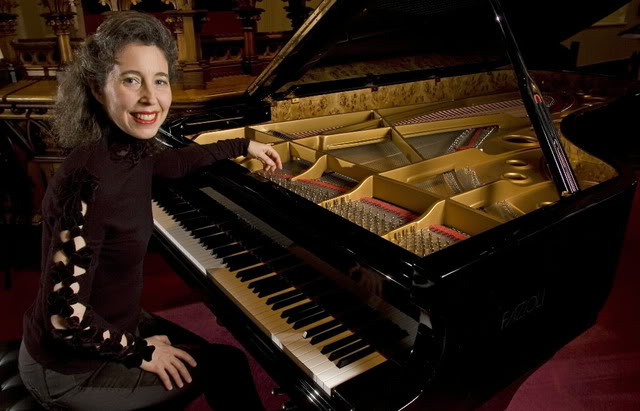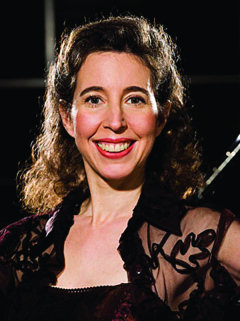Classical Music Review: The Hypnotically Lovely Playing of Pianist Angela Hewitt
Pianist Angela Hewitt’s performance was hypnotically lovely. She has a beautiful touch, as piano teachers like to say, and her playing was colorful and always elegant.
By Susan Miron
The Celebrity Series of Boston presented the renowned pianist Angela Hewitt on Friday night, December 2 to a large and enthused crowd. At intermission, I overheard many reminiscing about her previous appearance here two years ago. Some were critics who, uncharacteristically, paid for their own tickets. They, and many others, were serious fans.
This was the first time I had heard Ms. Hewitt in person. I have always been suspicious of musicians whose posters are festooned with hyperbole such as “The pre-eminent Bach pianist for our time,” (The Guardian) or “Nothing less than the pianist who will define Bach performance on the piano for years to come” (Stereophile). Seriously, there are quite a few amazing pianists out there who could fit these descriptions. So I entered Jordan Hall with doubts.
Ms. Hewitt may not be the very best Bach keyboard player out there, but she is damn good, and I was won over in the first movement of one of three (4, 5,6) of The Bach French Suites. Of all of Bach’s keyboard music, the six French Suites are performed least often. Number Six is popular, but few people (outside of keyboard players) know the others well, if at all. So it was revelatory to hear three Bach suites played, separated by suites of Debussy. It was ingenious programming.
The program opened with the Fourth French Suite in E-Flat Major, BWV 815, and from the first movement, Ms. Hewitt created a mesmerizing web of sound she sustained throughout her Bach and Debussy. The “French Suites” and “English Suites” were posthumously named. As the excellent program notes by Aaron Grad point out, all of Bach’s keyboard suites, including the six Partitas and the Overture in the French Style, are essentially French in manner, “borrowing conventions from the 17th-century, dance suite. Bach’s Suites were not intended as actual dance accompaniments, but they did preserve the telltale rhythms and tempos that characterized the original dance suites. The dances contained within the French Suites all crystallized in France, but some were of foreign origin, including the Allemande (German), the Sarabande (from Spain’s American colonies), the Polonaise (Polish) and the Gigue (related to the British Jig).”
Ms. Hewitt’s playing was hypnotically lovely. She has a beautiful touch, as piano teachers like to say, and her playing was colorful and always elegant. Her slow movements were beautifully paced and tastefully ornamented. Her voicing—allowing the audience to hear separate lines—was good indeed, and her pacing of the suites was excellent. Her performance of No. 4, along with the gorgeous French Suite No. 5 in G Major, BWV 816 and the French Suite No. 6 in E Major, BWV 817, was revelatory. (The Sixth is sometimes attempted on the harp, and having heard this performance, I decided it definitely belonged on the keyboard!)

Pianist Angela Hewitt — She has a beautiful touch, as piano teachers like to say, and her playing was colorful and always elegant.
The Debussy performances had the same lyricism and elegance that Ms. Hewitt achieved in the Bach. Before the encore, there were two suites and the famously wild “L’isle joyeuse.” The first, the Baroque inspired Suite Bergamasque (composed in 1890, published in 1905), is where the ever-if not overly-popular “Clair de lune” started its life. A few years ago, I transcribed this suite for harp, and it was glorious—when Debussy works on the harp, it really works. So it was a delight to hear a piece so close to my heart played so ravishingly by Ms. Hewitt. The Prèlude, Menuet, and Passepied (the first two and fourth movements) were played with exquisite attention to color, dynamics, and quicksilver mood changes. The warhorse “Clair de lune” was originally entitled “Promenade Sentimental” (and the Passepied was originally called Pavane). Reader, I dreaded hearing this piece. But, again, Ms. Hewitt exceeded my expectations. All of its dreaminess and shimmering magic came through; it was like hearing the music for the first time.
The other Debussy suite was “Pour le piano” (1901) whose two outer movements Prelude and Toccata are unabashedly virtuosic and were played with exquisite precision and excitement. The beautiful Sarabande, originally composed in 1894 as part of the collection Images, mirrors the stately pace of the Baroque sarabande.
“L’isle joyeuse” (1903–04) was inspired by a rococo painting by Antoine Watteau, The Embarkation for Cythera (1717), which depicts couples in a fantastical, outdoor scene. It’s a wild ride, with lots of whole-tone scales and exotic modes and a giddiness we don’t usually associate with Debussy. It got giddier in the encore, “Gollywog’s Cake Walk” from Debussy’s Children’s Corner Suite. Ms. Hewitt finally got a chance with these last two pieces to just let go and have a great time. As did the audience, who gave her a cheering standing O.


Let’s be done with these tired mistruths of classical music lore! Debussy’s “L’isle joyeuse” has nothing to do with Watteau’s painting. For a convincing explanation look at Roy Howat’s preface to the new collected works edition volume containing this music.
I agree entirely with the dispensing of doubt about her ability, having heard her for the first time this afternoon.
Thank for writing the above. I enjoyed reading it.